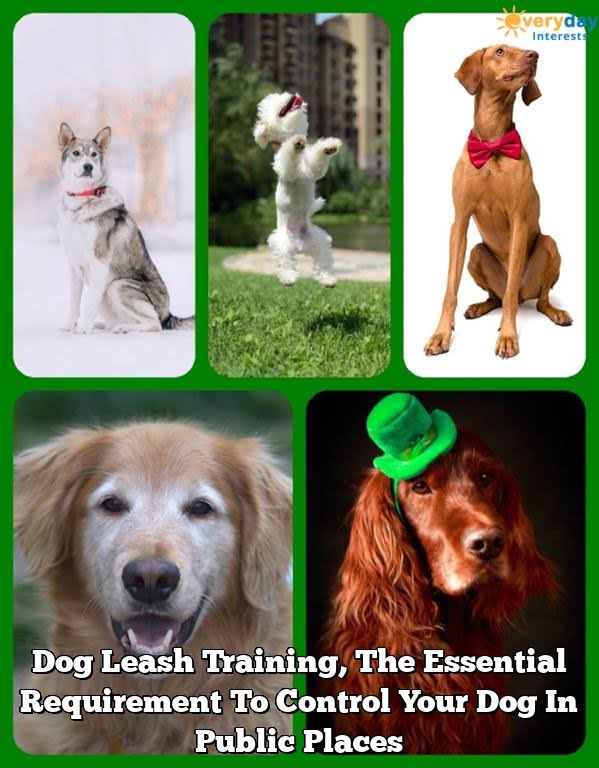Are you wondering, “how to train my dog to be calm in public?” Training your dog to behave calmly in public is an essential skill that can enhance both your and your dog’s overall quality of life.
Whether you enjoy taking your furry friend on walks, to outdoor cafes, or on road trips, having a well-behaved dog can make these experiences more enjoyable for everyone involved. In this article, we will discuss the importance of training your dog to be calm in public settings and provide you with practical tips on how to achieve this goal.
When it comes to being out and about with your canine companion, having a well-behaved dog can make all the difference. Not only does it reflect positively on you as a responsible pet owner, but it also ensures the safety and comfort of those around you. From navigating busy sidewalks to visiting pet-friendly establishments, training your dog to be calm in public can help reduce stress and improve the overall experience for both you and your pup.
In the following sections, we will guide you through a comprehensive training plan that covers everything from basic obedience training at home to desensitizing your dog to different environments and dealing with distractions. By implementing our tips and techniques, you can look forward to stress-free outings with your well-behaved furry companion. Let’s get started.
Assessing Your Dog’s Current Behavior in Public Settings
When it comes to training your dog to be calm in public, it’s important to start by assessing their current behavior in public settings. This step is crucial in understanding where your dog is at in terms of their ability to remain calm and well-behaved when out and about. By taking the time to assess your dog’s behavior, you can better tailor your training approach to address any specific issues or challenges they may have.
Observing Your Dog
The first step in assessing your dog’s behavior in public settings is to simply observe them in these environments. Take note of how they react to different stimuli, such as other dogs, people, loud noises, and new surroundings. Do they become anxious or fearful? Do they exhibit signs of aggression or hyperactivity? Understanding their reactions will provide valuable insight into the areas that need attention during training.
Evaluating Their Response to Commands
Another important aspect of assessing your dog’s behavior is evaluating their response to basic commands in public settings. Are they able to follow commands such as “sit,” “stay,” or “leave it” when there are distractions present? Assessing their obedience in these situations will help you gauge their level of control and focus, which are essential for remaining calm in public.
By thoroughly assessing your dog’s behavior in public settings, you can gain a clear understanding of the areas that need improvement and develop a targeted training plan to help them become more calm and well-behaved when out and about. Understanding where your dog currently stands will set the foundation for success as you work towards enjoying stress-free outings with your furry friend.
Establishing the Foundation
Basic obedience training is an essential first step in teaching your dog to be calm in public settings. This foundational training provides the structure and discipline that is necessary for your dog to exhibit good behavior when out and about. The key commands to focus on during this phase of training include sit, stay, down, come, and heel. These commands will form the basis of your dog’s behavior in public and allow you to effectively control their actions.
Consistency is crucial when it comes to basic obedience training. Set aside regular time each day to work with your dog on these commands, keeping each training session short and focused. Use positive reinforcement techniques such as treats and praise to encourage your dog to obey the commands consistently. By establishing a routine and creating clear expectations for their behavior at home, you are laying the groundwork for success when transitioning to public environments.
It’s important to remember that every dog learns at their own pace, so be patient and understanding throughout the process. Some dogs may pick up on basic obedience commands quickly, while others may require more time and repetition. Understanding your individual dog’s learning style will allow you to tailor your training methods to best suit their needs.
| Command | Description |
|---|---|
| Sit | Teaches the dog to sit on command, which can help keep them calm in public settings |
| Stay | Encourages the dog to remain in one place until given further instructions, preventing them from becoming over-excited or agitated in public |
| Come | Allows you to call your dog back to you if they become anxious or distracted in a public environment |
Desensitizing Your Dog to Public Environments
Understanding Desensitization Training
Desensitization training is a crucial step in teaching your dog to be calm in public settings. This technique involves exposing your dog to the sights, sounds, and smells of public environments in a controlled and gradual manner. The goal is to help your dog become less reactive and more relaxed when encountering potentially stressful stimuli.
Creating a Desensitization Plan
Start by identifying the specific triggers that cause your dog to become anxious or excited in public. Whether it’s other dogs, loud noises, or crowded spaces, understanding what sets off your dog will allow you to tailor a desensitization plan that targets these specific triggers. Gradually expose your dog to these triggers in a safe and controlled way, starting from a distance and progressively moving closer as your dog becomes more comfortable.
Practicing Patience and Consistency
Desensitization training requires patience and consistency. It’s important to proceed at your dog’s pace, never forcing them into a situation that causes distress. Use positive reinforcement, such as treats or praise, to reward calm behavior during desensitization exercises. Consistency is key – practice regularly and gradually increase the level of exposure over time. With dedication and perseverance, you can help your dog build the confidence to remain calm in public environments.
By following these desensitization techniques, you can effectively teach your dog how to be calm in public. Over time, with patience and consistent training, you will notice a significant improvement in your dog’s ability to remain composed and relaxed amidst various distractions outside the comfort of home.
Introducing Your Dog to Controlled Public Settings
After you have successfully desensitized your dog to public environments, the next step in training your dog to be calm in public is introducing them to controlled public settings. This is an important part of the process as it allows your dog to gradually become accustomed to being around people, other animals, and various stimuli in a controlled and safe manner.
Here are some tips for introducing your dog to controlled public settings:
1. Start with quiet locations: Begin by taking your dog to quieter public spaces such as a park with minimal foot traffic or a pet-friendly store during off-peak hours.
2. Use a leash and harness: Keep your dog on a leash and harness for safety and control during these initial outings.
3. Stay calm and confident: Dogs can pick up on their owner’s emotions, so it’s important to remain calm and confident during these outings. If you appear anxious or nervous, your dog may become apprehensive as well.
By gradually exposing your dog to controlled public settings and using positive reinforcement techniques, you can help them become more comfortable and well-behaved in various public environments. Remember to be patient and consistent with training efforts, as every dog progresses at their own pace when it comes to acclimating to new experiences.
Positive Reinforcement and Reward-Based Training Methods
When it comes to training your dog to be calm in public, positive reinforcement and reward-based training methods are essential. These training techniques focus on rewarding your dog for exhibiting the desired behavior, rather than using punishment or correction-based methods. Here are some effective strategies for incorporating positive reinforcement into your training routine:
- Use treats: When your dog displays calm behavior in a public setting, immediately reward them with their favorite treat. Over time, they will associate being calm with receiving a tasty reward.
- Verbal praise: In addition to treats, verbal praise can also be a powerful motivator for dogs. Whenever your dog remains calm in a public environment, shower them with praise and affection to reinforce the behavior.
- Clicker training: Clicker training is a popular method that involves using a clicking sound to mark the desired behavior, followed by a reward. This clear marker helps communicate to your dog exactly what they did right.
It’s important to remember that every dog is different, so it may take some trial and error to determine which rewards are most motivating for your furry companion. When using positive reinforcement, consistency is key. Be sure to reward your dog every time they exhibit calm behavior in public, and gradually reduce the frequency of rewards as they become more adept at remaining calm in various environments.
By incorporating these positive reinforcement and reward-based training methods into your routine, you can effectively teach your dog to remain calm in public settings while strengthening the bond between you and your canine companion.
Dealing With Distractions and Unexpected Situations
When training your dog to be calm in public, it’s important to acknowledge that distractions and unexpected situations will inevitably arise. These can include loud noises, other animals, or even excited children running around. It’s crucial to prepare your dog for these scenarios so that they can remain calm and well-behaved no matter what happens.
One effective way to address distractions is to gradually expose your dog to them in a controlled environment. For example, if your dog tends to become anxious around other dogs, start by introducing them to a calm and well-behaved canine friend. As your dog becomes more comfortable, gradually increase the level of distraction by introducing them to more energetic or vocal dogs.
Another aspect of dealing with unexpected situations is teaching your dog a “leave it” command. This command can be used when your dog encounters something potentially distracting or even dangerous, such as food on the ground or an approaching unfamiliar animal. Training this command takes time and patience as you will need to consistently reinforce it through positive reinforcement techniques.
It’s also important for you as the owner to remain calm and assertive during unexpected situations. Dogs are extremely perceptive of their owner’s emotions, so if you become anxious or stressed, your dog is more likely to mirror those feelings. By staying composed and confident, you can help guide your dog through any unexpected scenario with ease.
| Training Method | Effectiveness |
|---|---|
| Gradually exposing the dog to distractions | Highly effective in desensitizing the dog |
| “Leave it” command training | Useful for managing unexpected situations |
| Maintaining a calm demeanor as an owner | Crucial for guiding the dog through stressful situations |
Tips for Maintaining Your Dog’s Calm Behavior in Public
Once you have successfully trained your dog to be calm in public, it is important to maintain their good behavior consistently. This will ensure that your dog remains well-behaved and relaxed during outings, even in challenging or unpredictable situations. Here are a few tips for maintaining your dog’s calm behavior in public.
Firstly, consistency is key. Be sure to continue practicing obedience training and desensitization exercises both at home and in public settings. Regular reinforcement of these behaviors will help solidify your dog’s calm demeanor and prevent regression. Consistency also means enforcing the same rules and expectations each time you take your dog out in public.
Secondly, continue using positive reinforcement and reward-based training methods. Whenever your dog demonstrates calm behavior in a public setting, be sure to praise and reward them with treats or verbal encouragement. This will reinforce their understanding that staying calm leads to positive outcomes, further motivating them to behave well in the future.
Finally, be prepared for unexpected distractions or challenges that may arise during outings. Always have high-value treats or toys on hand to redirect your dog’s attention away from potential triggers. Additionally, stay alert and proactive in managing any potential sources of stress for your dog while out in public.
By consistently applying these tips, you can help maintain your dog’s calm behavior in public and continue enjoying stress-free outings together.
Remember that consistency, positive reinforcement, and preparation for unexpected situations are all crucial elements in maintaining your dog’s well-behaved demeanor when out in public. With patience and dedication, you can ensure that your furry companion remains relaxed and happy during any public outing.
Common Mistakes to Avoid When Training Your Dog to Be Calm in Public
When training your dog to be calm in public, there are common mistakes that you should avoid to ensure the success of your efforts. One mistake to avoid is rushing the process. It’s important to remember that training your dog to be calm in public takes time and patience.
Rushing the process can lead to frustration for both you and your dog, and may result in setbacks in their training progress. Take small steps and gradually increase the level of difficulty as your dog becomes more comfortable in public settings.
Another common mistake when training a dog to be calm in public is using punishment-based training methods. Punishing your dog for displaying anxious or excitable behavior in public can worsen their anxiety and lead to more problems down the line. Instead, focus on positive reinforcement and reward-based training methods. By rewarding calm behavior with treats, praise, or toys, you can help your dog associate being calm with positive outcomes.
Additionally, it’s important to avoid inconsistent training practices when working on calming your dog in public. Consistency is key when it comes to training any behavior, including being calm in public settings. Make sure that all family members or anyone else who interacts with your dog understands and follows the same training techniques and rules. Inconsistency can confuse your dog and make it harder for them to understand what is expected of them.
By avoiding these common mistakes and following a structured and patient approach, you can successfully train your dog to be calm in public. With time, consistent practice, and positive reinforcement, you’ll be able to enjoy stress-free outings with your well-behaved canine companion.
Conclusion
In conclusion, training your dog to be calm in public is not only beneficial for your peace of mind but also for the well-being of your furry companion. By understanding the importance of this training, assessing your dog’s current behavior, and establishing a strong foundation through basic obedience training at home, you are laying the groundwork for success.
Desensitizing your dog to public environments and gradually introducing them to controlled settings will further reinforce their ability to remain calm in various situations.
Positive reinforcement and reward-based training methods play a crucial role in shaping your dog’s behavior in public. By consistently rewarding calm and collected behavior, you are encouraging them to maintain this demeanor in the future. However, it is important to be prepared for distractions and unexpected situations that may arise. By practicing patience and utilizing the skills you have taught your dog, you can effectively navigate these challenges.
As you continue to train your dog to be calm in public, remember that consistency is key. Avoid common mistakes such as using punishment-based methods or allowing unwanted behaviors to go unchecked.
With dedication and perseverance, you can enjoy stress-free outings with a well-behaved dog who is a joy to have by your side in any environment. So if you’re asking yourself “how to train my dog to be calm in public“, following these steps can help you achieve just that.
Frequently Asked Questions
How Do I Train My Dog to Be Calm Around People?
Training your dog to be calm around people requires patience and positive reinforcement. Start by exposing your dog to different social situations gradually, rewarding calm behavior and providing a safe space.
How Can I Help My Dog With Public Anxiety?
To help your dog with public anxiety, it’s important to desensitize them to the environment. Start by bringing them to quieter public places, gradually increasing the exposure while offering reassurance and treats.
Can Dogs Be Trained to Be Calm?
Yes, dogs can be trained to be calm through consistent and patient training. Using positive reinforcement techniques such as rewards for desired behavior and gradually exposing them to different stimuli can help in achieving a calmer demeanor.

Welcome to the blog! I am a professional dog trainer and have been working with dogs for many years. In this blog, I will be discussing various topics related to dog training, including tips, tricks, and advice. I hope you find this information helpful and informative. Thanks for reading!





